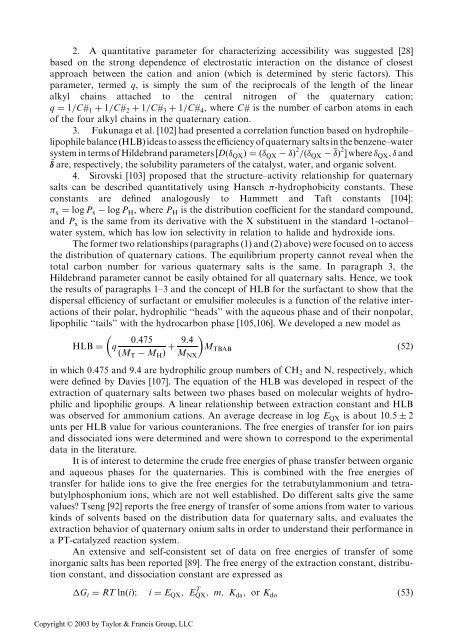11. Interfacial Mechanism and Kinetics of Phase-Transfer Catalysis
11. Interfacial Mechanism and Kinetics of Phase-Transfer Catalysis
11. Interfacial Mechanism and Kinetics of Phase-Transfer Catalysis
Create successful ePaper yourself
Turn your PDF publications into a flip-book with our unique Google optimized e-Paper software.
2. A quantitative parameter for characterizing accessibility was suggested [28]based on the strong dependence <strong>of</strong> electrostatic interaction on the distance <strong>of</strong> closestapproach between the cation <strong>and</strong> anion (which is determined by steric factors). Thisparameter, termed q, is simply the sum <strong>of</strong> the reciprocals <strong>of</strong> the length <strong>of</strong> the linearalkyl chains attached to the central nitrogen <strong>of</strong> the quaternary cation;q ¼ 1=C# 1 þ 1=C# 2 þ 1=C# 3 þ 1=C# 4 , where C# is the number <strong>of</strong> carbon atoms in each<strong>of</strong> the four alkyl chains in the quaternary cation.3. Fukunaga et al. [102] had presented a correlation function based on hydrophile–lipophile balance (HLB) ideas to assess the efficiency <strong>of</strong> quaternary salts in the benzene–watersystem in terms <strong>of</strong> Hildebr<strong>and</strong> parameters ½Dð QX Þ¼ð QX Þ 2 =ð QX Þ 2 Š where QX , <strong>and</strong> are, respectively, the solubility parameters <strong>of</strong> the catalyst, water, <strong>and</strong> organic solvent.4. Sirovski [103] proposed that the structure–activity relationship for quaternarysalts can be described quantitatively using Hansch -hydrophobicity constants. Theseconstants are defined analogously to Hammett <strong>and</strong> Taft constants [104]: x ¼ log P x log P H , where P H is the distribution coefficient for the st<strong>and</strong>ard compound,<strong>and</strong> P x is the same from its derivative with the X substituent in the st<strong>and</strong>ard 1-octanol–water system, which has low ion selectivity in relation to halide <strong>and</strong> hydroxide ions.The former two relationships (paragraphs (1) <strong>and</strong> (2) above) were focused on to accessthe distribution <strong>of</strong> quaternary cations. The equilibrium property cannot reveal when thetotal carbon number for various quaternary salts is the same. In paragraph 3, theHildebr<strong>and</strong> parameter cannot be easily obtained for all quaternary salts. Hence, we tookthe results <strong>of</strong> paragraphs 1–3 <strong>and</strong> the concept <strong>of</strong> HLB for the surfactant to show that thedispersal efficiency <strong>of</strong> surfactant or emulsifier molecules is a function <strong>of</strong> the relative interactions<strong>of</strong> their polar, hydrophilic ‘‘heads’’ with the aqueous phase <strong>and</strong> <strong>of</strong> their nonpolar,lipophilic ‘‘tails’’ with the hydrocarbon phase [105,106]. We developed a new model as0:475HLB ¼ qðM T M H Þ þ 9:4 M TBABð52ÞM NXin which 0.475 <strong>and</strong> 9.4 are hydrophilic group numbers <strong>of</strong> CH 2 <strong>and</strong> N, respectively, whichwere defined by Davies [107]. The equation <strong>of</strong> the HLB was developed in respect <strong>of</strong> theextraction <strong>of</strong> quaternary salts between two phases based on molecular weights <strong>of</strong> hydrophilic<strong>and</strong> lipophilic groups. A linear relationship between extraction constant <strong>and</strong> HLBwas observed for ammonium cations. An average decrease in log E QX is about 10:5 2unts per HLB value for various counteranions. The free energies <strong>of</strong> transfer for ion pairs<strong>and</strong> dissociated ions were determined <strong>and</strong> were shown to correspond to the experimentaldata in the literature.It is <strong>of</strong> interest to determine the crude free energies <strong>of</strong> phase transfer between organic<strong>and</strong> aqueous phases for the quaternaries. This is combined with the free energies <strong>of</strong>transfer for halide ions to give the free energies for the tetrabutylammonium <strong>and</strong> tetrabutylphosphoniumions, which are not well established. Do different salts give the samevalues? Tseng [92] reports the free energy <strong>of</strong> transfer <strong>of</strong> some anions from water to variouskinds <strong>of</strong> solvents based on the distribution data for quaternary salts, <strong>and</strong> evaluates theextraction behavior <strong>of</strong> quaternary onium salts in order to underst<strong>and</strong> their performance ina PT-catalyzed reaction system.An extensive <strong>and</strong> self-consistent set <strong>of</strong> data on free energies <strong>of</strong> transfer <strong>of</strong> someinorganic salts has been reported [89]. The free energy <strong>of</strong> the extraction constant, distributionconstant, <strong>and</strong> dissociation constant are expressed asG i ¼ RT lnðiÞ; i ¼ E QX ; E T QX; m; K da ; or K do ð53ÞCopyright © 2003 by Taylor & Francis Group, LLC
















